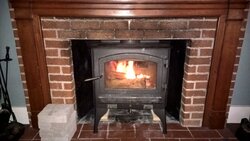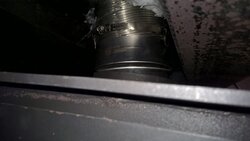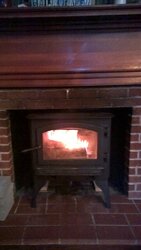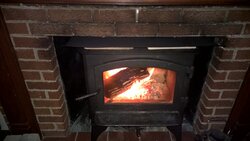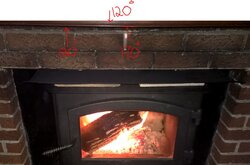Well, it took some time but the stove is finally installed. It was a huge pain getting the stove in place, mostly because it was only me maneuvering and lifting the stove (my body is killing me today). I decided to jack up the stove and install the legs instead of setting it on bricks as the previous owner had done - this brought the height of the stove up, but at least it is how its supposed to be.I do wish that I could have gotten the connection to sit a bit straighter in the stove collar, but it is very tight (see picture) and the entire area is tight to work with in general.
Also, I know that the top of the stove is too close to the start of my mantel piece - I honestly think i'm just going to cut that portion of the mantel to give it the necessary clearance.
Regardless, I did a test fire last night and everything went well - no leaks, good draft, long burn, and I really did notice a difference with the added insulation. Before bed, I had a hot bed of coals and when I woke up this morning the stove was still warm. Last year, if I let that happen the stove would have been cold already.
Obviously the stove is not an ideal set up, but it works for me for now. Maybe in a year or two I'll take it out and just have the stove free standing with standard stove pipe setup.
Thank you for all the help and advice! Any other suggestions or comments are appreciated.
Also, I know that the top of the stove is too close to the start of my mantel piece - I honestly think i'm just going to cut that portion of the mantel to give it the necessary clearance.
Regardless, I did a test fire last night and everything went well - no leaks, good draft, long burn, and I really did notice a difference with the added insulation. Before bed, I had a hot bed of coals and when I woke up this morning the stove was still warm. Last year, if I let that happen the stove would have been cold already.
Obviously the stove is not an ideal set up, but it works for me for now. Maybe in a year or two I'll take it out and just have the stove free standing with standard stove pipe setup.
Thank you for all the help and advice! Any other suggestions or comments are appreciated.


